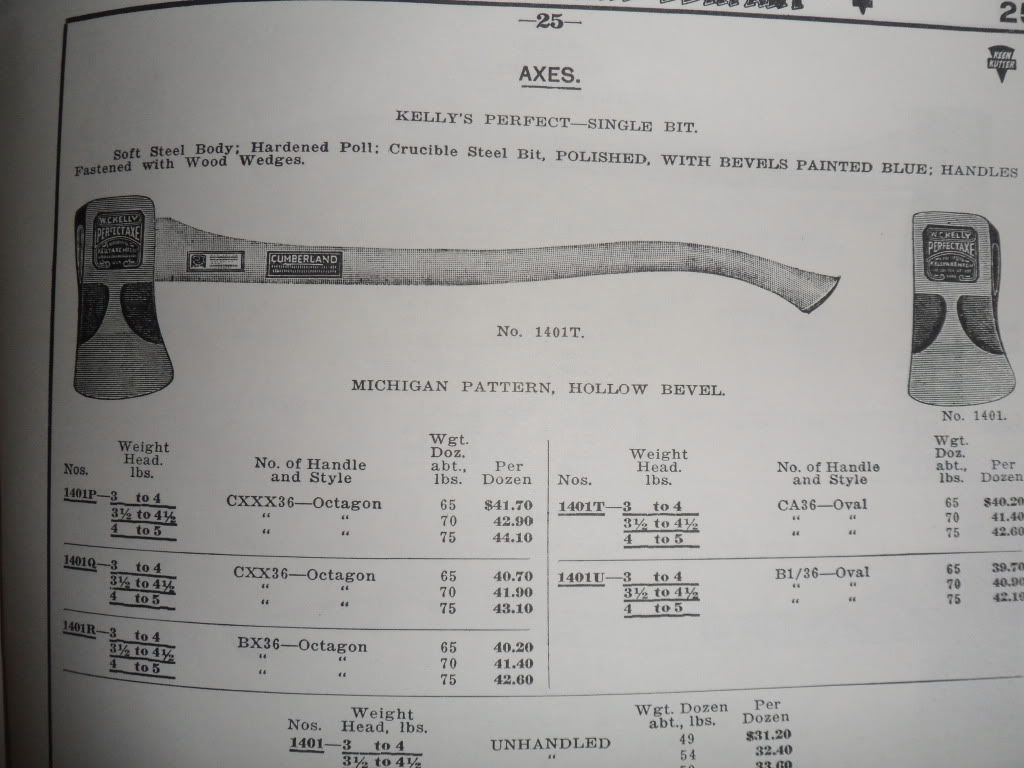- Joined
- Sep 24, 2010
- Messages
- 2,395
Well using should depend on what it looks like really.
The BladeForums.com 2024 Traditional Knife is available! Price is $250 ea (shipped within CONUS).
Order here: https://www.bladeforums.com/help/2024-traditional/
Is curly maple ok for the handle?






I told my wife to keep an eye out for old axes and this was the first thing she found at an antique shop. $25
Its about 3lbs and has only seen light if any use. It just says True Temper Kelly Perfect. The edges are very hard, a file barely cuts at the tips. The handle was warped from leaning against a wall for so many years. I tried to steam it but it didn't work.
Maybe I missed something from the thread but it seams like it still is going to be hard to date this one. I think its a good one but have no idea when it was made.



Another Kelly Ax Variation. 2.5 lb. Double Bit Cruiser. Anyone seen this stamping before?

...Let me get this correct. This Kelly Hand-Made Cruiser could be from 1913!?! Most likely made before 1949? On the other side I can barely make out the stamping that reads "True Temper" with "Kelly Works" beneath it.
Some clarifications, and it's complicated.
True Temper Kelly Perfect Axes were being advertised in 1938, as far as I know:
http://books.google.com/books?id=JQNEAAAAIAAJ&q=%22true+temper%22+axe&dq=%22true+temper%22+axe&hl=en&sa=X&ei=rAtrU42OC8n4oAS4_oH4Ag&ved=0CG4Q6AEwCQ
So, if an axe says "True Temper" it could be from as early as 1938 (or perhaps earlier?)
Here are some details of the True Temper puzzle:
Based on info from yesteryearstools.com,
If it says "Kelly Works" it's from 1930 or later.
Acquisition of Kelly Axe Mfg. Co. and Operation as Kelly Works 1930-1949+
Corporation Name Changed to True Temper 1949-1987+
from http://www.yesteryearstools.com/Yesteryears%20Tools/American%20Fork%20%26%20Hoe%20Co..html
1949 is the year that American Fork and Hoe (owner of Kelly Axe since 1930) changed the A.F.&H. name to True Temper, BUT there were some True Temper axes out there before 1949.
Here's an ad from 1941 for True Temper axes:
http://books.google.com/books?id=iycDAAAAMBAJ&lpg=PA221&dq=%22true%20temper%22%20axe&pg=PA221#v=onepage&q=%22true%20temper%22%20axe&f=false
A reference to "Kelly True Temper axes" from 1939:
[link no longer works]
American Fork & Hoe was using the True Temper brand as early as 1907...
I've seen a bunch of Kelly Hand Made brand axes online, but don't recall seeing a 2.5 pound cruiser stamped that way.
Information from an earlier post shows that the Hand Made brand was Kelly's fifth most expensive brand in 1913, tied with Flint Edge, Black Raven, Vulcan...
Here's a list of Kelly axe brands, from most expensive to least expensive (based on Kelly's 1913 price list):
1. Kelly Registered
2. Columbian
3. Perfect / Hand Honed (tie)
4. Copper King / Silver Edge / Chip Slinger (tie)
5. Flint Edge / Vulcan / Black Raven / Hand Made ... (tie)
6. Wood Slasher / Jim Dandy (tie)
The Kelly Registered cost 33% more than the Kelly Perfect.
Kelly Perfect cost more than Black Raven.
Black Raven and Hand Made cost the same as Flint Edge.
Wood Slasher was the lowest-cost brand.
(Cost are generally listed as per dozen heads, and the cost difference between brands can be relatively small.)

from National Hardware Bulletin, September, 1913
I would make a few suppositions based on their pricing scheme. I suspect that they had only 2 or possibly 3 levels of steel quality. The rest was all stylistic differences.
It's easy to guess that the Woodslasher and Jim Dandy lines were of the cheaper steel. The Kelly Standard and New Era lines wold be upscale versions of the Woodslasher class axes.
Similarly the 'Flint Edge' class axes were of the same (higher) quality steel. The increased cost of the Perfect could be explained by using that same steel and adding the full polish. These older Perfects wouldn't have the hardened poll that was advertised in later editions. The other higher priced axes could also be explained by stylistic improvements of the Flint Edge class axes.
The 'Registered' may be a 3rd steel class or it could be that the increase in cost was simply due to the quality of finish and paying for the warranty. There also might have been higher QC in the production of the Registered axes.
Any one have an opinion about this? Are there more logical divisions?
Also, similar to breweries having cheaper brands that (I've long suspected) are batches that didn''t turn out so well, the axe manufacturer could use a different label for factory "seconds" (and maybe even "thirds"), instead of scrapping them. So some of those cheaper axe labels might be from a run of product that had heat treatment equipment settings that were slightly "off", for example. This might explain an apparent difference in steel quality (even if the steel composition is exactly the same in both cases, and getting what was supposed to be the same heat treatment in both cases).
I also wondered if they used a couple different types of steel.
see below images from the the other kelly axe thread
note on this one for the perfects it says "crucible steel bit"

and for the woodslasher, it says "good grade axe steel"

